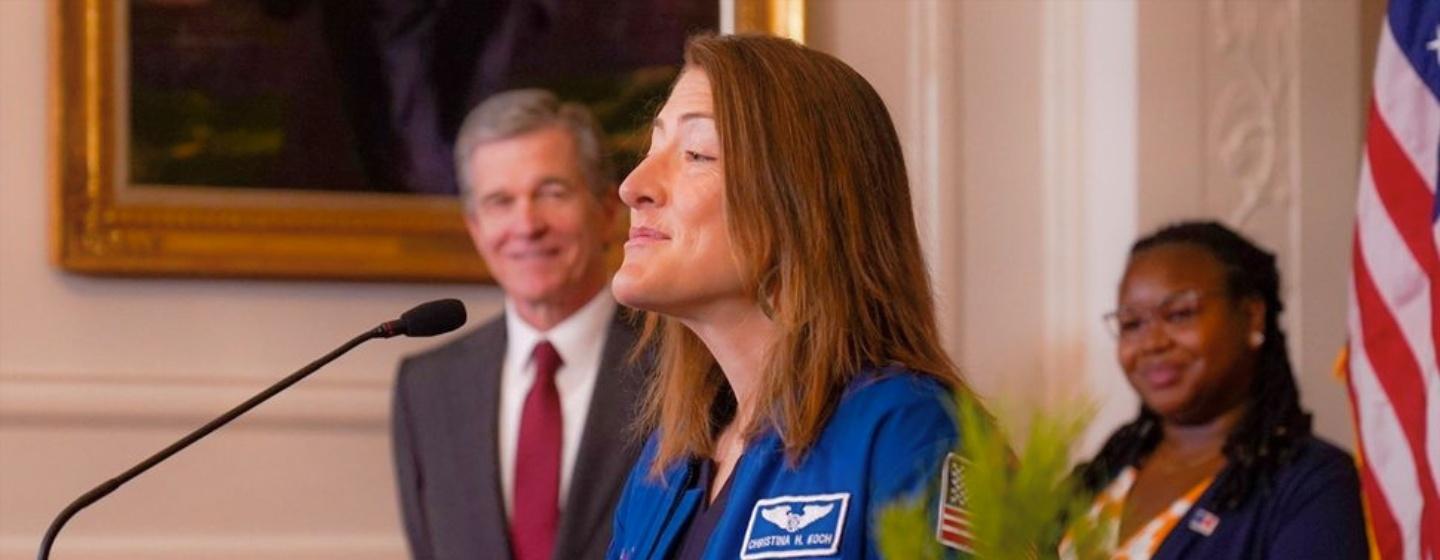Artemis ‘Moon Tree’ Lands in North Carolina


There’s a special new tree growing on the grounds of the North Carolina governor’s mansion in downtown Raleigh. You could say it’s out of this world.
In late April, NASA astronaut and North Carolina native Christina Koch presented Governor Roy Cooper with a “Moon Tree,” a sapling germinated from seeds flown around the Moon on the Artemis I mission in 2022.
“With the planting of an Artemis Moon Tree today at the Governor’s mansion, North Carolina is firmly planting the roots of exploration for generations to come,” said Koch. “It is an honor to share the excitement of space with students and future explorers in my home state. These students make up the Artemis generation and allow humanity to accomplish big things in space and on Earth in the future.”
Koch also presented Governor Cooper with a North Carolina flag that was flown aboard the International Space Station (ISS) during Expeditions 59, 60 and 61 from 2019 to 2020.
“Astronaut Koch’s journey from North Carolina public schools to space is inspiring to all of us and shows the amazing opportunities that come from a public-school education in our state,” said Cooper.
Koch, who grew up in Jacksonville, attended the North Carolina School of Science and Mathematics in Durham and White Oak High School in Jacksonville. She graduated from NC State, where she earned Bachelor of Science degrees in electrical engineering and physics and a Master of Science degree in electrical engineering. Koch later received an honorary doctoral degree from her alma mater.
In 2013, Koch was selected for the astronaut corps and served as a flight engineer on the ISS for three expeditions. She’ll return to space as Mission Specialist 1 on NASA’s Artemis II mission, which is planned to launch in September 2025. It will be the first mission to take humans into lunar orbit in 50 years.
The concept of the Moon Tree took root on the Apollo 14 mission in 1971, when NASA astronaut Stuart Roosa, the command module pilot and a former USDA Forest Service smoke jumper, carried tree seeds into space. The seeds were from tree varieties he knew well during his time with the USDA: loblolly pine (a plant native to NC), American sycamore, sweet gum, coast redwood and Douglas fir.
During the mission, Roosa remained in lunar orbit in command module Kitty Hawk, conducting experiments and keeping watch over the seeds. He completed 34 lunar orbits, while crewmates Alan Shepard and Edgar Mitchell spent two days exploring the lunar surface.
After splashdown, the seeds went into quarantine just like the astronauts, then a standard protocol meant to prevent Moon microbes from infecting anything on Earth. Over the next few years, saplings from those seeds were planted across the U.S., including many in 1976 as part of the nation’s bicentennial celebration.
Although the Moon Trees garnered local interest, there wasn’t a lot of national attention given to them, and the program soon faded from view. NASA archivists, however, have been tracking down the original Moon Trees. You can see where some were planted on NASA’s website.
The latest version of Moon Trees launched in 2022, when one thousand seeds from five different tree species representing a range of climates across the lower 48 states were packed into pouches for their journey on the first flight of the Artemis program.
The mission, dubbed Artemis I, was the first test flight for the Orion spacecraft, which will carry astronauts to the Moon. Sensors in the cabin monitored how all systems were performing. Sitting in one of the astronauts’ seats was the data-gathering mannequin Commander Moonikin Campos. Aside from important sensory-gathering hardware, Commander Campos wore the first generation of NASA’s new space attire, the Orion Crew Survival System suit.
The pouches of seeds, tucked between the sensors, spent about three weeks in space, traveling 240,000 miles to the Moon and then 40,000 miles beyond, breaking the record for the farthest distance a spacecraft designed for human exploration has ever flown.
Without a crew onboard, NASA engineers used the additional flight time to test Orion’s guidance, navigation, communications, thermal controls and other systems.
There was, however, one notable difference between the Moon Tree seeds in the original program and this one.
“Four of the five species flown on the original Moon Trees mission [were] onboard [Artemis I] because they … represent a broad geographic area of the lower 48 states,” said Dr. Kasten Dumroese, senior scientist with the USDA Forest Service in a news release. Adding that they replaced coast redwood, which has a somewhat limited range, “with its cousin, giant sequoia, which has more widespread use in parks and arboreta.”
The mission also included additional seed sources for the American sycamore and Douglas fir, two species with large natural ranges.
Once again, the Forest Service germinated the Moon Tree seeds and grew them into seedlings. Public and educational institutions across the U.S. can apply to serve as Moon Tree custodians. Learn more here.
The Moon Tree seeds have completed their mission with Artemis I, however, NASA still has three more Artemis missions planned, including Artemis III, which will land humans on the lunar surface.
Learn more about the Artemis program, including the mission that will send NC astronaut Christina Koch and three other crew members into lunar orbit, here.